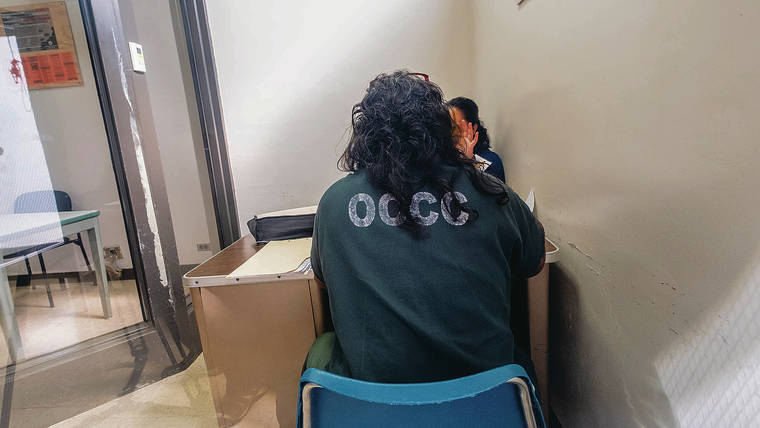Release of Hawaii inmates nears amid coronavirus crisis

DENNIS ODA / NOV. 20, 2019
An inmate at Oahu Community Correctional Center (OCCC) is seen talking to her lawyer in a visitation area. A public defender will identify inmates who are eligible for release amid worries that overcrowded conditions could increase the potential spread of coronavirus among inmates and staff.
The Hawaii Supreme Court late Friday took a major step toward allowing the release of a segment of the state’s 2,000-plus prison population amid worries that overcrowded conditions could increase the potential spread of coronavirus Opens in a new tab among inmates and staff.
In an interim order filed at 5:09 p.m. Friday, the court gave Public Defender James Tabe until 4:30 p.m. Monday to submit a list of prisoners who fall into one of three categories based on length of sentence, severity of offense and whether they are in pretrial status for lesser crimes.
The order gives Hawaii Attorney General Clare Connors, the four county prosecutors and others a chance to raise objections to the release of individual inmates and recommend conditions of release. It also doesn’t preclude the possibility of inmates outside the three categories from being released.
The Public Defender’s Office and prisoner advocates on Tuesday petitioned the court to commute or suspend the sentences of inmates serving time for petty misdemeanor or misdemeanor offenses, citing concerns that overcrowded conditions could elevate the potential for widespread infection within the state’s prison system.
It’s unclear how many inmates would be eligible for release based on the criteria or if they would be required to report back to prison once the threat is over.
The three categories are:
Don't miss out on what's happening!
Stay in touch with breaking news, as it happens, conveniently in your email inbox. It's FREE!
>> Inmates serving sentences, not to exceed 18 months, as a condition of felony probation. Disqualifying exceptions include those serving sentences for major criminal offenses such as murder, assault, sexual assault and kidnapping.
>> Inmates serving sentences for misdemeanor or petty misdemeanor convictions. Not eligible would be those convicted of abusing family or household members or those who violated temporary restraining orders, injunctions, protection orders and restraining orders.
>> All pretrial detainees charged with petty misdemeanors or misdemeanor offenses, except those charged with abusing family or household members or violating TROs, protection orders, restraining orders or injunctions.
It is “a moral imperative as well as a legal issue,” Tabe said in a court filing, to “reduce the state’s jail populations to the extent possible without compromising public safety.”
“It is inevitable that the virus will spread into the jails and prison facilities, and, when that happens, the health and well-being of inmates and staff members will be at tremendous risk.”
The Hawaii Correctional Oversight Commission on Friday sent a letter to Gov. David Ige urging him not only to reduce the prison population but to gather stakeholders as a working group to take other actions to address conditions for those who must remain.
“We believe that reducing the population, though necessary, may not be enough to prevent quick spreading of COVID-19 among the inmates and staff,” the commission wrote.
The AG’s office, prosecutors and corrections officials said they concur that action needs to be taken to reduce the prison population because of the outbreak. The Department of Public Safety said it identified 52 inmates at the Halawa Correctional Facility and five from the Women’s Correctional Center who are slated to be released by June 30.
Kevin Takata, the deputy attorney general who supervises the Criminal Justice Division, said details need to be worked out. “It’s not an easy decision,” he said. “The people who are in custody are in custody because of the risk they present.”
If his office does agree to the release of certain inmates, “we want to ensure that they have a place to live,” Takata said. “We’re not going to release people to place them on the streets to become homeless, thereby almost compelling them to commit crimes to survive.”
Prosecutors also need to be able to track those who are released, he said.
Additionally, “in most of the cases, we’re not going to agree to a simple abdication of their sentence. It’s more like a delay of the jail time that they must serve.”
Interim Order by Honolulu Star-Advertiser on Scribd




